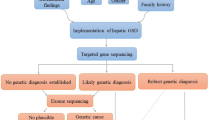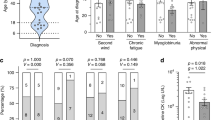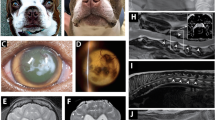Abstract
Glycogen storage disease type IIIa (GSD IIIa) is an autosomal recessive disorder characterized by excessive accumulation of abnormal glycogen in the liver and muscles and caused by a deficiency in the glycogen debranching enzyme. The spectrum of AGL mutations in GSD IIIa patients depends on ethnic group—prevalent mutations have been reported in the North African Jewish population and in an isolate such as the Faroe islands, because of the founder effect, whereas heterogeneous mutations are responsible for the pathogenesis in Japanese patients. To shed light on molecular characteristics in Egypt, where high rate of consanguinity and large family size increase the frequency of recessive genetic diseases, we have examined three unrelated patients from the same area in Egypt. We identified three different individual AGL mutations; of these, two are novel deletions [4-bp deletion (750–753delAGAC) and 1-bp deletion (2673delT)] and one the nonsense mutation (W1327X) previously reported. All are predicted to lead to premature termination, which completely abolishes enzyme activity. Three consanguineous patients are homozygotes for their individual mutations. Haplotype analysis of mutant AGL alleles showed that each mutation was located on a different haplotype. Our results indicate the allelic heterogeneity of the AGL mutation in Egypt. This is the first report of AGL mutations in the Egyptian population.
Similar content being viewed by others
Introduction
Glycogen storage disease type III (GSD III; MIM #232400) is an autosomal recessive inherited disorder characterized by fasting hypoglycemia, growth retardation, hepatomegaly, progressive myopathy, and cardiomyopathy (Chen 2001). GSD III is caused by a deficiency in the glycogen debranching enzyme, a key enzyme in the degradation of glycogen. The enzyme has two independent catalytic activities, oligo-1,4-1,4-glucantransferase (EC 2.4.1.25) and amylo-1,6-glucosidase (EC 3.2.1.33), on a single 160-kDa protein. The glycogen-binding site is assumed to be located in the carboxyl terminal of its protein. Both activities and glycogen binding are required for complete function. In GSD III patients, enzyme activities are virtually absent in affected organs. Most patients have both liver and muscle involvement (GSD IIIa), but approximately 15% of the patients have solely liver involvement without any muscular manifestations (GSD IIIb). These subtypes have been explained by differences in tissue expression of the deficient enzyme.
The human AGL gene (AGL) has been isolated and shown to be 85 kb in length and composed of 35 exons, encoding a 7.0-kb mRNA (Bao et al. 1996). Multiple tissue-specific isoforms of AGL mRNAs, differing only at the 5′- end, have been reported, and the predominant form, liver glycogen debranching enzyme, is predicted to have 1,532 amino acids, deduced from mRNA isoform 1 (Bao et al. 1997). Molecular analyses of GSD IIIa have been performed in Caucasian, Japanese, Italian, Jewish, and several other ethnic populations (Shen and Chen 2002) and over 50 different AGL mutations have been reported in GSD III patients (Human Gene Mutation Database; http://www.hgmd.org).
The spectrum of AGL mutations in GSD IIIa varies among ethnic groups. In an ethnic group with a high rate of consanguinity, prevalent mutations have been reported. For example, in the North African Jewish population, a single AGL mutation (4455delT) is prevalent (Parvari et al. 1997). In the Faroe islands, a small archipelago in the North Atlantic and an isolate, one specific mutation (R408X) is responsible for GSD IIIa patients (Santer et al. 2001). Information on prevalent mutations helps facilitate DNA-based diagnosis of GSD III in these specific populations.
In contrast, genetic heterogeneity has been shown in other ethnic groups. We have reported the heterogeneity of AGL mutations in Japan. Eleven different mutations have been identified in our studies (Horinishi et al. 2002; Okubo et al. 1996, 1998, 1999, 2000a, b). Lucchiari et al. (2002) discovered genetic heterogeneity in Italian patients also, although one splicing mutation (IVS21+1G>A) accounts for 28%. In Caucasian populations four mutations make up approximately 28% of all GSD IIIa patients, but the rest of the mutations are heterogeneous (Shen and Chen 2002). These findings show that the spectrum of AGL mutations in GSD IIIa depends on ethnic group.
In Egypt, Arab is the major ethnic group. The Arabs do not usually prohibit marriages with relatives, and consanguinity rates range between 20 and 60% (Teebi et al. 2002). Moreover, families have an average of 5.3 children in Egypt. Both high rates of consanguinity and large family size increase the frequency of autosomal recessive genetic diseases. These factors suggested to us that a prevalent mutation might be found in Egyptian GSD IIIa patients. To address this question, we have examined three unrelated patients from the same area in Egypt. We identified three different mutations in the three patients and observed allelic heterogeneity of GSD IIIa in Egypt. This is the first report of AGL mutations in the Egyptian population.
Materials and methods
Patients
Three Egyptian GSD IIIa patients from three unrelated families were investigated. They were from the delta region in Egypt (Fig. 1). The patients were confirmed as having deficient debranching enzyme activity in peripheral red blood cells by the method of Shin (1990). All patients showed both liver and muscle involvement and were diagnosed with GSD IIIa. Consanguinity was ascertained in all families. The study was approved by the local ethics committees and performed with the patients’ and their families’ informed consent.
DNA sequence analysis of the AGL gene
Genomic DNA was isolated from peripheral blood leukocytes. The full coding exons, their relevant exon–intron boundaries, and the 5′- and 3′-flanking regions of the patients’ AGL genes were sequenced directly as described previously (Okubo et al. 2000b). The nucleotides of AGL cDNA were numbered according to AGL isoform 1 (GenBank accession no. NM_000642).
Mutation analysis of the AGL gene
Point mutations identified in patients were verified using restriction fragment length polymorphism (RFLP). A pair of primers (listed in Table 1) was used for PCR and each specific-restriction endonuclease was added to digest PCR products. Restriction digests were analyzed on polyacrylamide gel. Fifty-five Japanese control subjects were examined by RFLP in the same manner to eliminate the possibility they are mere polymorphisms in controls.
Haplotype determination in the AGL gene
Twenty-three polymorphic markers in the AGL gene were genotyped in accordance with previous reports (Horinishi et al. 2000, 2002; Okubo et al. 2000b; Shen et al. 1997).
Results
We identified three different AGL mutations in the three unrelated Egyptian patients.
Sequence analysis for patient 1 revealed a 4-bp deletion from nucleotides 750–753 (750–753delAGAC) in exon 7 (Fig. 2). Deletion of 4 bp results in a frame shift, leading to premature termination at codon 273. RFLP analysis with restriction enzyme PshAI confirmed that patient 1 was homozygous for the 4-bp deletion.
Mutational analysis for patient 1. A. In the upper panel the sequence electropherogram of the antisense strand corresponding to the 4-bp deletion in exon 7 of the AGL gene is shown. The point of the deletion is indicated by an arrow. Patient 1 was homozygous for the 4-bp deletion. Normal sequence from a control is shown in the lower panel. B. Electrophoretic analysis of PCR products after digestion with Psh AI. M, DNA marker; P1, patient 1; C, control. Patient 1 had a 125-bp fragment alone, verifying homozygosity for the 750-753delAGAC mutation
Patient 2 had a 1-bp deletion of nucleotide 2673 (2673delT) in exon 21 (Fig. 3). Deletion of 1 bp causes premature termination at codon 899, because of a frame shift. RFLP analysis with restriction enzyme BstPAI verified that patient 2 was homozygous for the 1-bp deletion.
Mutational analysis for patient 2. A. In the upper panel the sequence electropherogram of the antisense strand corresponding to the 1-bp deletion in exon 21 is shown. The point where the deletion occurred is indicated by an arrow. Patient 2 was homozygous for the 1-bp deletion. Normal sequence from a control is shown in the lower panel. B. Electrophoretic analysis of PCR products after digestion with Bst PAI. M, DNA marker; P2, patient 2; C, control. Patient 2 had 77-bp and 29-bp fragments, verifying homozygosity for the 2673delT mutation
Sequence analysis for patient 3 revealed a G-to-A substitution at nucleotide 3980 in exon 31 that replaces tryptophan by termination at codon 1327 (W1327X) (Fig. 4). RFLP analysis with XbaI indicated that patient 3 was homozygous for W1327X.
Mutational analysis for patient 3. A. In the upper panel the sequence electropherogram of the sense strand in exon 31 is shown. A G-to-A substitution at nucleotide 3980 in patient 3 is indicated by an arrow. Patient 3 was homozygous for the nonsense mutation (W1327X). Normal sequence from a control is shown in the lower panel. B. Electrophoretic analysis of PCR products after digestion with Eco RI. M, DNA marker; P3, patient 3; C, control. Patient 3 had an 89-bp fragment alone, verifying homozygosity for the W1327X mutation
These three mutations were not found in the 55 normal controls.
Haplotype analysis of three mutant alleles demonstrated that each mutation was located on a different AGL haplotype (Table 2).
Discussion
We have shown the allelic heterogeneity of the AGL mutation in Egypt. Our genetic analysis of three Egyptian patients from the same area revealed three different mutations. Furthermore, haplotype analysis revealed that each mutation was located on a different AGL haplotype. These findings suggest that no founder mutations are present in the Egyptian population and that heterogeneous mutations are responsible for the disease in Egyptian GSD IIIa patients. We are trying to recruit more GSD IIIa patients to confirm our finding.
We have revealed three different AGL mutations for individual families. Patient 1 is homozygous for 750–753delAGAC and patient 2 is homozygous for 2673delT. Both small deletions are predicted to lead to truncated proteins lacking the glycogen-binding site in the carboxyl terminal, because of frame shift. These are novel AGL mutations that have not previously been reported. Patient 3 is a homozygote for W1327X. All are predicted to lead to premature termination, which completely abolishes enzyme activity. These premature stop codons will probably be recognized as nonsense-mediated decay, leading to the absence of AGL mRNA. These results are consistent with the finding that most of the mutations reported thus far are nonsense mutations caused by a nucleotide substitution, deletion, or insertion (Shen and Chen 2002).
As far as we are aware patient 3 is the second patient with the W1327X mutation. Lucchiari et al. (2002) has reported W1327X in a Tunisian GSD III patient. We could not discover whether or not W1327X is a recurrent mutation, because no information on the haplotype of the Tunisian patient was given in Lucchiari’s study. The two patients could share a common ancestor, because Egypt and Tunisia are geographically near, located in North Africa, and the main ethnic group in both countries is Arab.
In summary, we identified three different AGL mutations in Egyptian GSD IIIa patients, showing that molecular defects of AGL were heterogeneous in Egypt. This is the first report of AGL mutations in Egyptian patients.
References
Bao Y, Dawson TL Jr, Chen YT (1996) Human glycogen debranching enzyme gene (AGL): complete structural organization and characterization of the 5′ flanking region. Genomics 38:155–165
Bao Y, Yang BZ, Dawson TL Jr, Chen YT (1997) Isolation and nucleotide sequence of human liver glycogen debranching enzyme mRNA: identification of multiple tissue-specific isoforms. Gene 197:389–398
Chen YT (2001) Glycogen storage diseases. In: Scriver CR, Beaudet AL, Sly WS, Valle D (eds) The metabolic and molecular bases of inherited disease, 8th edn., vol I. McGraw–Hill, New York, NY, pp 1521–1551
Horinishi A, Murase T, Okubo M (2000) Novel intronic polymorphisms (IVS6-73A/G and IVS21+124A/G) in the glycogen-debranching enzyme (AGL) gene. Hum Mutat 16:279
Horinishi A, Okubo M, Tang NL, Hui J, To KF, Mabuchi T, Okada T, Mabuchi H, Murase T (2002) Mutational and haplotype analysis of AGL in patients with glycogen storage disease type III. J Hum Genet 47:55–59
Lucchiari S, Donati MA, Parini R, Melis D, Gatti R, Bresolin N, Scarlato G, Comi GP (2002) Molecular characterisation of GSD III subjects and identification of six novel mutations in AGL. Hum Mutat 20:480
Okubo M, Aoyama Y, Murase T (1996) A novel donor splice site mutation in the glycogen debranching enzyme gene is associated with glycogen storage disease type III. Biochem Biophys Res Commun 224:493–499
Okubo M, Horinishi A, Nakamura N, Aoyama Y, Hashimoto M, Endo Y, Murase T (1998) A novel point mutation in an acceptor splice site of intron 32 (IVS32 A-12→G) but no exon 3 mutations in the glycogen debranching enzyme gene in a homozygous patient with glycogen storage disease type IIIb. Hum Genet 102:1–5
Okubo M, Kanda F, Horinishi A, Takahashi K, Okuda S, Chihara K, Murase T (1999) Glycogen storage disease type IIIa: first report of a causative missense mutation (G1448R) of the glycogen debranching enzyme gene found in a homozygous patient. Hum Mutat 14:542–543
Okubo M, Horinishi A, Suzuki Y, Murase T, Hayasaka K (2000a) Compound heterozygous patient with glycogen storage disease type III: identification of two novel AGL mutations, a donor splice site mutation of Chinese origin and a 1-bp deletion of Japanese origin. Am J Med Genet 93:211–214
Okubo M, Horinishi A, Takeuchi M, Suzuki Y, Sakura N, Hasegawa Y, Igarashi T, Goto K, Tahara H, Uchimoto S, Omichi K, Kanno H, Hayasaka K, Murase T (2000b) Heterogeneous mutations in the glycogen-debranching enzyme gene are responsible for glycogen storage disease type IIIa in Japan. Hum Genet 106:108–115
Parvari R, Moses S, Shen J, Hershkovitz E, Lerner A, Chen YT (1997) A single-base deletion in the 3′-coding region of glycogen-debranching enzyme is prevalent in glycogen storage disease type IIIA in a population of North African Jewish patients. Eur J Hum Genet 5:266–270
Santer R, Kinner M, Steuerwald U, Kjaergaard S, Skovby F, Simonsen H, Shaiu WL, Chen YT, Schneppenheim R, Schaub J (2001) Molecular genetic basis and prevalence of glycogen storage disease type IIIA in the Faroe Islands. Eur J Hum Genet 9:388–391
Shen JJ, Chen YT (2002) Molecular characterization of glycogen storage disease type III. Curr Mol Med 2:167–175
Shen J, Liu HM, Bao Y, Chen YT (1997) Polymorphic markers of the glycogen debranching enzyme gene allowing linkage analysis in families with glycogen storage disease type III. J Med Genet 34:34–38
Shin YS (1990) Diagnosis of glycogen storage disease. J Inherit Metab Dis 13:419–434
Teebi AS, Teebi SA, Porter CJ, Cuticchia AJ (2002) Arab genetic disease database (AGDDB): a population-specific clinical and mutation database. Hum Mutat 19:615–621
Acknowledgements
This study was supported in part by Grant-in-Aid for Scientific Research C #13670856 to M.O. from the Japan Society for the Promotion of Science
Author information
Authors and Affiliations
Corresponding author
Rights and permissions
About this article
Cite this article
Endo, Y., Fateen, E., Aoyama, Y. et al. Molecular characterization of Egyptian patients with glycogen storage disease type IIIa. J Hum Genet 50, 538–542 (2005). https://doi.org/10.1007/s10038-005-0291-3
Received:
Accepted:
Published:
Issue Date:
DOI: https://doi.org/10.1007/s10038-005-0291-3
Keywords
This article is cited by
-
A mutation analysis of the AGL gene in Korean patients with glycogen storage disease type III
Journal of Human Genetics (2014)
-
Molecular features of 23 patients with glycogen storage disease type III in Turkey: a novel mutation p.R1147G associated with isolated glucosidase deficiency, along with 9 AGL mutations
Journal of Human Genetics (2009)
-
Molecular analysis of the AGL gene: heterogeneity of mutations in patients with glycogen storage disease type III from Germany, Canada, Afghanistan, Iran, and Turkey
Journal of Human Genetics (2006)
-
Spätmanifestation einer Polyglykosankörpermyopathie
Der Nervenarzt (2006)







